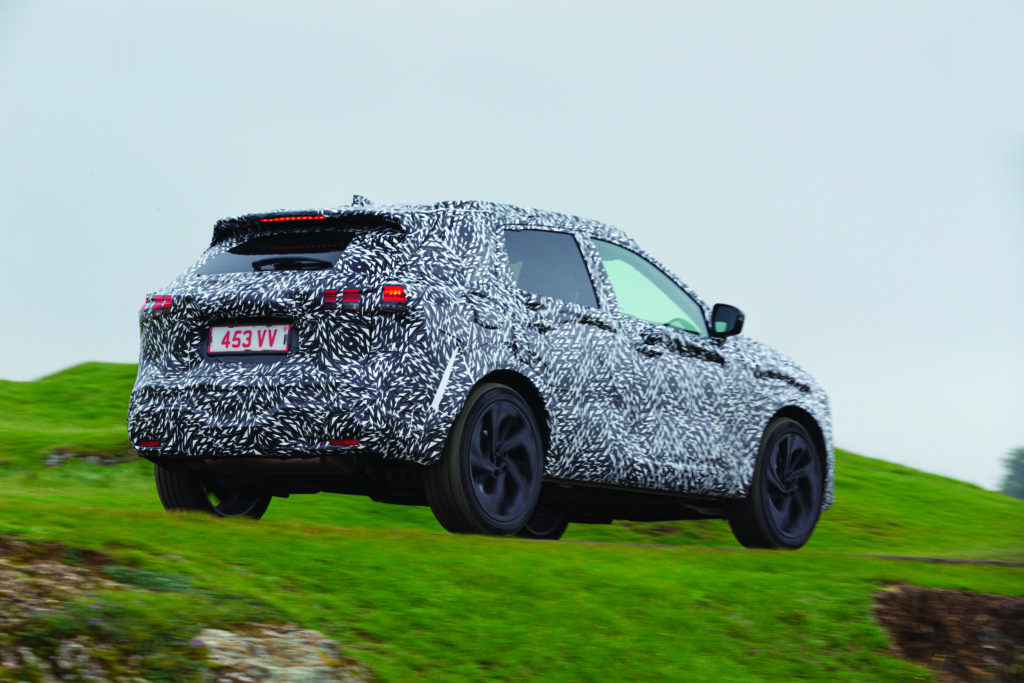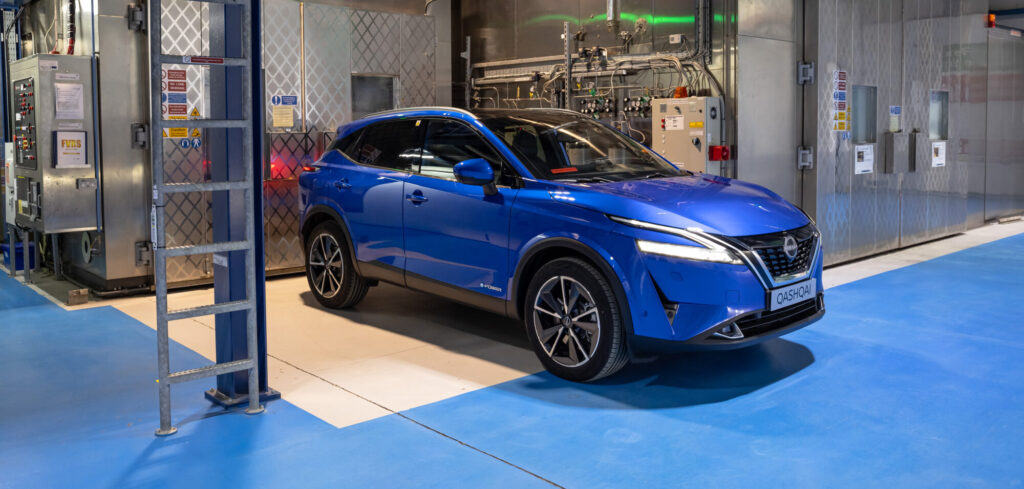ATTI hears the highlights of the baby SUV regime, and learns more about the brand’s engineering formulae.
Some might say that the Nissan Qashqai is the most ‘British’ mainstream vehicle on sale. It was designed at the company’s Paddington studio in London, engineered at the Nissan Technical Centre Europe (NTCE) in Cranfield and built at the firm’s Sunderland factory.
Russell Taverner (below right) is manager of C-segment customer-oriented engineering and test management at NTCE. He was deeply involved in the third-generation Qashqai since initial discussions started in 2015, and is one of thousands who were involved during the multiyear program.
“Some teams work on a specific element of the project at a specific time,” he explains. “Others will be involved for longer periods. Inside R&D, as well as the teams working directly on the design and development of this specific model there will be others working on cross-car technologies that are applied to this and other Nissan models.
 “I am fortunate that my team specifically is one of the few that is involved at the start of the concept creation and remains involved up to the start of production and beyond.”
“I am fortunate that my team specifically is one of the few that is involved at the start of the concept creation and remains involved up to the start of production and beyond.”
In general, a new vehicle program can be broadly broken down into three phases: concept creation, digital development and physical validation. Each one, Taverner explains, has its own schedule and requirements. “Concept creation is the groundwork of the vehicle. It involves looking at what our customers want from the car, what competitiveness and attractiveness targets we want to set, and what technologies we want to develop for it to enhance our customers’ lives.
“Digital development is where we start to see the parts and technologies come together in a virtual environment. This phase it could also include some physical validation by mock-up, 3D printing or whole mule-vehicle creation.
“Then at the physical validation stage we take all that data and build whole vehicle prototypes for testing, before running various production trials at the manufacturing location.”
Detail oriented
Simulation also happens in stages, and at first the numbers are broad. “The further we get into development, the more refined it becomes,” says Taverner. “During these simulations we need to check that we are meeting various targets for performance, future regulations and styling requirements, and ensure it can be made in our factories.”The Nissan Qashqai is a famously practical vehicle, and its utility was validated through exhaustive simulations, checks and assessments of all areas of vehicle performance.
“We created whole vehicle ergonomics mules in conjunction with early styling data,” says Taverner. “Then with CAD data we made whole vehicle assemblies for simulation in a digital environment. Using VR technology we can put ourselves outside or inside the car to check usability.
“We made full renders of the vehicle that were photorealistic and manipulatable as to viewing point, to conduct appearance-based checks and reflection studies. The aerodynamics team tested physical full-size clay models in wind tunnels as well as using CFD simulations.
Meanwhile, dynamic performance teams simulated objective data and backed that up with mule vehicles using advanced prototype parts. The electrical teams created whole-vehicle electrical benches to connect all the control units together and check for software glitches months before they were put inside a car.”
According to Taverner, major changes during digital testing are rare, however some minor refinements will be made. “Of course, if an issue is found, it’s good to find it during the simulations so that we can have a cross-functional meeting and decide the best direction for the project together.”
Taverner has followed the shift to a virtual-led development landscape over his 20 years at Nissan. He says that when he started, the first prototype cars were built with more prototype components than today or by using soft (short-lifecycle) tooling: “Now we can build the first prototype cars with the final tooling because our digital evaluation is that much more advanced.”
Moment of truth
However, simulation cannot replace every facet of real-world evaluation. At NTCE’s two sites, Cranfield and Barcelona, there’s a raft of analysis resources used to test whole vehicles, trimmed bodies and component assemblies. These include water shower chambers, hot and cold environment chambers, whole-vehicle body-durability rigs including a climatic four-poster vibration rig in Cranfield, a materials lab, anechoic chambers – the list goes on.“Real-world testing is vital to development, considering the variety of scenarios customers may face throughout the life of a vehicle. We conducted cold-weather field testing in the north of Scandinavia and hot-weather testing in the south of Spain. We even drove up mountains and steep slopes with the cars fully laden with sandbags to validate the powertrain and brake performance,” says Taverner.
He adds that the SUV’s automated driving tech and Nissan Safety Shield technology were scrutinized during multi-country fleet tests to ensure that the performance met targets on various road conditions. Millbrook served as a key test location due to its proximity to the NTCE facility.
Qashqai was completed on time and to budget – something to be incredibly proud of. “We have a good estimation process for budget setting, which is done early in the project to allocate necessary resources. The biggest issues for vehicle test budgets are external influences,” reveals Taverner. “Developing a car during Brexit and Covid didn’t make things easy, especially when trying to organize pan-European testing and transportation of cars.
“At the end of the day,” he concludes, “a vehicle will not go into production unless it has been completely tested and the team is 100% happy that it meets the requirements of customers.”
Odd jobs
Nissan does several tests that may be considered unusual but were necessary to guarantee the durability of the SUV. “Obviously we try to replicate customer usage, such as by putting mud on the seats and carpet to check that it can be easily cleaned off,” comments Nissan Technical Centre Europe’s Russell Taverner.Another example from the Qashqai regime was when deciding the surface texture (grain) of the cup holders. “We know coffee often spills from takeaway cups, so we made up a few samples of materials,” Taverner explains. “We spilled milky coffee on them and checked for the optimum finish to ensure good appearance and friction, but also cleanability that doesn’t rip cloths and tissues. We love nerdy tests like these!”
A few years ago the team heard of an old automated car wash in France, which Taverner says didn’t have very good sensors on it and could potentially damage exterior fittings. “We went and measured the force it exerted on a car. We now use those findings to test that things such as rear spoilers will not be damaged by such a car wash. The force exerted is so much that we have to strap the car to the floor to stop it rolling back and forth.”
At NTCE in Cranfield there is an odor evaluation lead engineer, Peter Karl Eastland (below), who has a master’s degree in chemistry – and an extremely acute sense of smell. “It is part of our job
to make sure that any material we use remains perfect in terms of scent, and that all the senses are harmonized,” Eastland says.Nissan has its own global standard for scent evaluation. The evaluation process for odors includes objective and subjective analyses, with the engineering and manufacturing teams sharing opinions with one another. The NTCE also frequently liaises with the OEM’s other tech centers in Atsugi in Japan and Farmington Hills in Michigan.
Eastland adds, “With any change or new design, potential odors will need to be part of the wider evaluation of the effectiveness of that change.”


